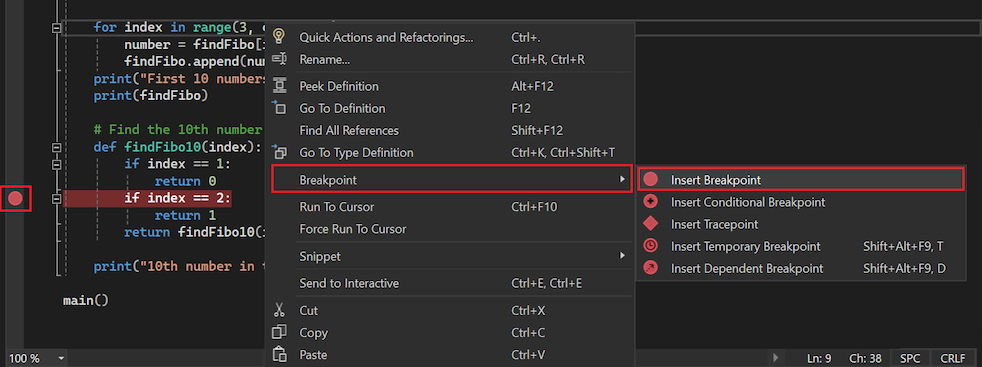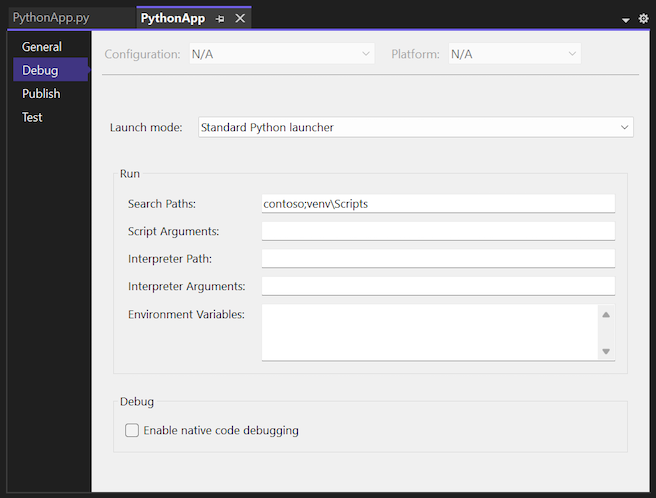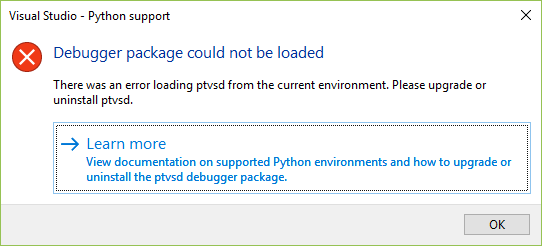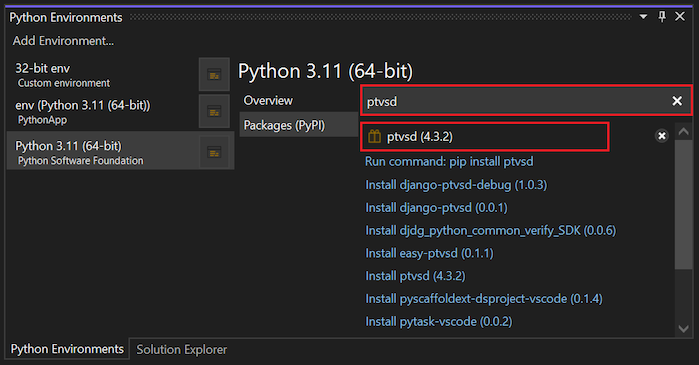Debug your Python code in Visual Studio
Visual Studio provides a comprehensive debugging experience for Python. In this article, you explore how to attach the debugger to running processes and evaluate expressions in the Watch and Immediate windows. In the debugger, you can inspect local variables, use breakpoints, step in/out/over statements, Set Next Statement, and more.
For scenario-specific debugging information, see the following articles:
Prerequisites
Visual Studio installed with support for Python workloads. For more information, see Install Python support in Visual Studio.
Python code to use with the debugger.
Debug code with or without a project
If you want to control your Python environment and arguments, first create a project for your code. You can create a project with the From existing Python code project template. For more information, see Create a project from existing Python code files.
However, you don't need a project or solution file in Visual Studio to debug your Python code. To debug code in a standalone Python file, open your file in Visual Studio, and select Debug > Start Debugging. Visual Studio launches the script with the global default environment and no arguments. You then have full debugging support for your code. For more information, see Python environments.
Explore basic debugging
The basic debugging workflow involves settings breakpoints, stepping through code, inspecting values, and handling exceptions. You can start a debugging session by selecting Debug > Start Debugging or use the F5 keyboard shortcut. For a project, these actions launch the startup file with the project's active environment and any command-line arguments or search paths specified for Project Properties. To configure the properties, see Set project debugging options.
Set the project startup file
The startup file for a project is shown in bold in Solution Explorer. You can choose which file to use as the startup file.
- To specify a project file as the startup file, right-click the file and select Set as Startup Item.
In Visual Studio 2017 version 15.6 and later, you see an alert if you don't have a specified startup file set. Earlier versions of Visual Studio might open an Output window with the Python interpreter running, or the Output window briefly opens and closes.
Specify the active environment
If you're using a project file, the debugger always starts with the active Python environment for the project. You can change the current active environment. For more information, see Select a Python environment for a project.
If you're debugging a standalone Python code file, Visual Studio launches the script with the global default environment and no arguments.
Set breakpoints
Breakpoints stop execution of code at a marked point so you can inspect the program state.
Some breakpoints in Python can be surprising for developers who have worked with other programming languages. In Python, the entire file is executable code, so Python runs the file when it's loaded to process any top-level class or function definitions. If a breakpoint is set, you might find the debugger breaking part-way through a class declaration. This behavior is correct, even though it's sometimes surprising.
To set a breakpoint, select in the left margin of the code editor or right-click a line of code and select Breakpoint > Insert Breakpoint. A red dot appears on each line that has a set breakpoint.
To remove a breakpoint, select the red dot or right-click the line of code and select Breakpoint > Delete Breakpoint. You can also disable a breakpoint by selecting the red dot and selecting Breakpoint > Disable Breakpoint.
Set conditions and actions
You can customize the conditions under which a breakpoint is triggered, such as breaking only when a variable is set to a certain value or value range.
To set conditions, right-click the breakpoint's red dot, select Conditions. The Breakpoint Settings dialog opens.
In the dialog, you can add multiple conditions and create conditional expressions by using Python code. For full details on this feature in Visual Studio, see Breakpoint conditions.
You also have the options to set Actions for a breakpoint. You can create a message to log to the Output window and optionally specify to continue execution automatically.
Logging a message creates a tracepoint that doesn't add logging code to your application directly.
Depending on how you configure conditions and actions for a breakpoint, the red icon in the left margin changes to indicate your settings. You might see the dot shape, a clock timer, or a diamond.
Step through code
When Visual Studio stops code execution at a breakpoint, there are several commands you can use to step through your code or run blocks of code before breaking again. The commands are available in a few places in Visual Studio, including the Debugger toolbar, the Debug menu, the right-click context menu in the code editor, and through keyboard shortcuts.
The following table summarizes these commands and provides the keyboard shortcut:
| Command | Shortcut | Description |
|---|---|---|
| Continue | F5 | Run code until you reach the next breakpoint. |
| Step Into | F11 | Run the next statement and stop. If the next statement is a call to a function, the debugger stops at the first line of the called function. |
| Step Over | F10 | Run the next statement, including making a call to a function (running all its code) and applying any return value. This command allows you to easily skip functions that you don't need to debug. |
| Step Out | Shift+F11 | Run the code until the end of the current function, then step to the calling statement. This command is useful when you don't need to debug the remainder of the current function. |
| Run to Cursor | Ctrl+F10 | Run the code up to the location of the caret in the editor. This command allows you to easily skip over a segment of code that you don't need to debug. |
| Set Next Statement | Ctrl+Shift+F10 | Change the current run point in the code to the location of the caret. This command allows you to omit a segment of code from being run at all, such as when you know the code is faulty or produces an unwanted side-effect. |
| Show Next Statement | Alt+Num+\ | Return to the next statement to run in the code. This command helps you locate the place in your code where the debugger is stopped. |
Inspect and modify values
When you stop code execution in the debugger, you can inspect and modify the values of variables. You can also use the Watch window to monitor individual variables and custom expressions. For more information, see Inspect variables.
To view a value by using the DataTips feature during debugging, hover the mouse over any variable in the editor. You can select the variable value to change it:
To use the Autos window, select Debug > Windows > Autos. This window contains variables and expressions that are close to the current statement. You can double-click in the value column or select and enter F2 to edit the value:
For more information on using the Autos window, see Inspect variables in the Autos and Locals windows.
To use the Locals window, select Debug > Windows > Locals. This window displays all variables that are in the current scope, which can again be edited:
For more information on using the Locals window, see Inspect variables in the Autos and Locals windows.
To use the Watch windows, select Debug > Windows > Watch > Watch 1-4. This option allows you to enter arbitrary Python expressions and view the results. Expressions are reevaluated for each step:
For more information on using the Watch window, see Set a watch on variables with the Watch and QuickWatch windows.
To inspect a string value, select View (magnifying glass) on the right side of the Value entry. The
str,unicode,bytes, andbytearraytypes are all available for inspection.The View dropdown menu displays four visualization options: Text, HTML, XML, or JSON.
After you select a visualization, a popup dialog shows the unquoted string value according to the selected type. You can view the string with wrapping and scrolling, syntax highlighting, and tree views. These visualizations can help to debug issues with long and complex strings.
View exceptions
If an error occurs in your program during debugging, but you don't have an exception handler for it, the debugger breaks at the point of the exception:
When an error occurs, you can inspect the current program state, including the call stack. However, if you step through the code, the debugging process continues to throw the exception until it's handled or your program exits.
To see an expanded view of exceptions, select Debug > Windows > Exception Settings.
In the Exceptions Settings window, the checkbox next an exception controls whether the debugger always breaks when that exception is raised.
To break more often for a particular exception, select the checkbox next to the exception in the Exception Settings window.
By default, most exceptions break when an exception handler can't be found in the source code. To change this behavior, right-click any exception and modify the Continue When Unhandled in User Code option. To break less often for the exception, deselect this option.
To configure an exception that doesn't appear in the Exception Settings window, select Add (plus symbol). Enter a name for the exception to watch. The name must match the full name of the exception.
Configure project debugging options
By default, the debugger starts your program with the standard Python launcher, no command-line arguments, and no other special paths or conditions. You can configure the startup options for a Python project by setting the debug properties.
To access the debug properties for a project, right-click your Python project in Solution Explorer, select Properties, and then select the Debug tab.
The following sections describe the specific properties.
Define launch behavior
The following table lists possible values for the Launch mode property. Use this property to define the launch behavior for the debugger.
| Value | Description |
|---|---|
| Standard Python launcher | Use debugging code written in portable Python compatible with CPython, IronPython, and variants like Stackless Python. This option provides the best experience for debugging pure Python code. When you attach to a running python.exe process, the launcher specified in this property is used. This launcher also provides mixed-mode debugging for CPython, which allows you to step seamlessly between C/C++ code and Python code. |
| Web launcher | Start your default browser on launch and enable debugging of templates. For more information, see the Web template debugging section. |
| Django Web launcher | Implement identical behavior to the Web launcher property but for a Django environment. Use this option only for the purposes of backwards compatibility. |
| IronPython (.NET) launcher | Use the .NET debugger, which works only with IronPython but allows for stepping between any .NET language project, including C# and Visual Basic. This launcher is used if you attach to a running .NET process that hosts IronPython. |
Define run behavior
The following table describes properties you can set to configure the running behavior for the debugger.
| Property | Description |
|---|---|
| Search Paths | Specify the file and folder search paths Visual Studio uses for your project. These values match the items shown in the project's Search Paths node in Solution Explorer. While you can specify search paths in this dialog, it can be easier to use Solution Explorer, where you can browse folders and automatically convert paths to relative form. |
| Script Arguments | Define the arguments to add to the command Visual Studio uses to launch your script, and appear after your script's filename. The first item listed in the value is available to your script as sys.argv[1], the second as sys.argv[2], and so on. |
| Interpreter Arguments | List the arguments to add to the launcher command line before the name of your script. Common arguments are -W ... to control warnings, -O to slightly optimize your program, and -u to use unbuffered IO. IronPython users are likely to use this field to pass -X options, such as -X:Frames or -X:MTA. |
| Interpreter Path | Identify an interpreter path to override the path associated with the current environment. The value might be useful for launching your script with a nonstandard interpreter. |
| Environment Variables | Use this property to add entries of the form <NAME>=\<VALUE>. Visual Studio applies this property value last, on top of any existing global environment variables, and after PYTHONPATH is set according to the Search Paths setting. As a result, this setting can be used to manually override any of those other variables. |
Work with interactive windows
There are two interactive windows you can use during a debugging session: the standard Visual Studio Immediate window and the Python Debug Interactive window.
Open the Immediate window
You can use the standard Visual Studio Immediate window to quickly evaluate Python expressions and inspect or assign variables in your running program. For more information, see Immediate window.
- To open the Immediate window, select Debug > Windows > Immediate. You can also use the keyboard shortcut Ctrl+Alt+I.
Open the Debug Interactive window
The Python Debug Interactive window offers a rich environment with the full Interactive REPL experience available while debugging, including writing and running code. This window automatically connects to any process started in the debugger by using the Standard Python launcher, including processes attached through Debug > Attach to Process. However, this window isn't available when using mixed-mode C/C++ debugging.
To use the Debug Interactive window, select Debug > Windows > Python Debug Interactive (Shift+Alt+I).
The Debug Interactive window supports special meta-commands in addition to the standard REPL commands, as described in the following table:
| Command | Description |
|---|---|
$continue, $cont, $c |
Start running the program from the current statement. |
$down, $d |
Move the current frame one level down in the stack trace. |
$frame |
Display the current frame ID. |
$frame |
Switch the current frame to the specified frame ID. - Requires a <frame ID> argument. |
$load |
Load commands from file and executes until complete. |
$proc |
Display the current process ID. |
$proc |
Switch the current process to the specified process ID. - Requires a <process ID> argument. |
$procs |
List the processes currently being debugged. |
$stepin, $step, $s |
Step into the next function call, if possible. |
$stepout, $return, $r |
Step out of the current function. |
$stepover, $until, $unt |
Step over the next function call. |
$thread |
Display the current thread ID. |
$thread |
Switch the current thread to the specified thread ID. - Requires a <thread ID> argument. |
$threads |
List the threads currently being debugged. |
$up, $u |
Move up the current frame one level in the stack trace. |
$where, $w, $bt |
List the frames for the current thread. |
The standard debugger windows such as Processes, Threads, and Call Stack aren't synchronized with the Debug Interactive window. If you change the active process, thread, or frame in the Debug Interactive window, the other debugger windows aren't affected. Similarly, changing the active process, thread, or frame in the other debugger windows doesn't affect the Debug Interactive window.
Use the legacy debugger
Depending on your environment configuration, you might need to use the legacy debugger:
- Visual Studio 2017 version 15.7 and earlier with Python 2.6, 3.1 to 3.4, or IronPython
- Visual Studio 2019 version 16.5 and later with Python 2.6, 3.1 to 3.4, or IronPython
- ptvsd 3.x and early 4.x versions
The legacy debugger is the default in Visual Studio 2017 version 15.7 and earlier.
- To use the legacy debugger, select Tools > Options, expand the Python > Debugging options, and select the Use legacy debugger option.
Support older Visual Studio or Python versions
Visual Studio 2017 version 15.8 and later use a debugger based on ptvsd version 4.1 and later. Visual Studio 2019 version 16.5 and later use a debugger based on debugpy. These two versions of the debugger are compatible with Python 2.7 or Python 3.5 and later.
If you're running one of these versions of Visual Studio, but you're using Python 2.6, 3.1 to 3.4, or IronPython, Visual Studio shows the error, Debugger does not support this Python environment:
When Visual Studio reports this environment error, you must use the legacy debugger.
Support older ptvsd versions
If you're using an older version of ptvsd in the current environment (such as an earlier 4.0.x version, or a 3.x version required for remote debugging), Visual Studio might show an error or warning.
If your environment uses ptvsd 3.x, Visual Studio shows the error, Debugger package could not be loaded:
The warning, Debugger package is outdated, appears when you're using an earlier 4.x version of ptvsd:
When Visual Studio reports these environment errors, you must use the legacy debugger.
Important
Although you might choose to ignore the warning for some versions of ptvsd, Visual Studio might not work correctly.
Manage your ptvsd installation
Follow these steps to manage your ptvsd installation:
In the Python Environments window, go to the Packages tab.
Enter ptvsd in the search box and examine the installed version of ptvsd:
If the version is lower than 4.1.1a9 (the version bundled with Visual Studio), select the X to the right of the package to uninstall the older version. Visual Studio then uses its bundled version. (You can also uninstall from PowerShell by using the
pip uninstall ptvsdcommand.)Alternatively, you can update the ptvsd package to its newest version by following the instructions in the Troubleshoot debug scenarios section.
Troubleshoot debug scenarios
The following scenarios describe other troubleshooting options for your debugging configuration.
Upgrade ptvsd for Visual Studio 2019
If you have issues with the debugger in Visual Studio 2019 version 16.4 and earlier, first upgrade your version of the debugger as follows:
In the Python Environments window, go to the Packages tab.
Enter ptvsd --upgrade in the search box, then select Run command: pip install ptvsd --upgrade. (You can also use the same command from PowerShell.)
If issues persist, file an issue on the PTVS GitHub repository.
Note
For Visual Studio 2019 version 16.5 and later, debugpy is part of the Visual Studio Python workload and is updated along with Visual Studio.
Enable debugger logging
In the course of investigating a debugger issue, Microsoft might ask you to enable and collect debugger logs to help in diagnosis.
The following steps enable debugging in the current Visual Studio session:
Open a command window in Visual Studio by selecting View > Other Windows > Command Window.
Enter the following command:
DebugAdapterHost.Logging /On /OutputWindowStart debugging and go through the steps necessary to reproduce your issue. During this time, debug logs appear in the Output window under Debug Adapter Host Log. You can then copy the logs from that window and paste into a GitHub issue, email, and so on.
If Visual Studio stops responding or you aren't otherwise able to access the Output window, restart Visual Studio, open a command window, and enter the following command:
DebugAdapterHost.Logging /OnStart debugging and reproduce your issue again. The debugger logs are located in
%temp%\DebugAdapterHostLog.txt.
Related content
Feedback
Coming soon: Throughout 2024 we will be phasing out GitHub Issues as the feedback mechanism for content and replacing it with a new feedback system. For more information see: https://aka.ms/ContentUserFeedback.
Submit and view feedback for


















